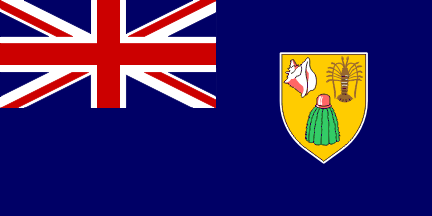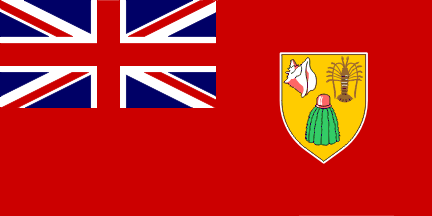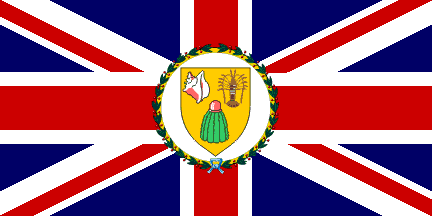 image by Martin Grieve, 22 June 2004
image by Martin Grieve, 22 June 2004
Last modified: 2024-12-14 by rob raeside
Keywords: turks and caicos | jamaica | bahamas | conch | crayfish | america | caribbean | shell | lobster | cactus | pelican | sisal |
Links: FOTW homepage |
search |
disclaimer and copyright |
write us |
mirrors
 image by Martin Grieve, 22 June 2004
image by Martin Grieve, 22 June 2004
Official Name: Turks and Caicos Islands
Capital: Grand Turk (Cockburn Town)
Flag adopted: 1999
(first adopted - 7 November 1968)
Coat of arms adopted: 28 September 1965
See also:
Under British rule in 1766. 1804 - Turks Islands ruled by
Jamaica. 1848 - Caicos Islands joined the Turks Islands in a
separated administrative territory of Jamaica. 1962 - Separated
from Jamaica (independent) and administered from the Bahamas. The
arms were granted in 1965, after the separation from Jamaica. The
flag is use since 1968. In 1973 Turks and Caicos became a
distinct colony as Bahamas became independent.
Joan-Francois Blanc, 13 November 1996
The administrative sequence was:
Until 1959 the T&C were a dependency of Jamaica; in 1959 the
T&C became a separate colony but until 1962 the Governor of
Jamaica was also the Governor of T&C. Between 1962 and 1965
the Administrator of the T&C reported directly to London.
Between 1965 and 1973 the Administrator was subordinate to the
Governor of the Bahamas who was also Governor of the T&C. In
1973 when Bahamas became independent the Administrator was
up-graded to Governor.
David Prothero, 30 July 1997
Turks/Caicos and the Cayman Islands were dependencies of
Jamaica. Turks had its own badge based on the Seal of the colony
from 1875 until 1958 when it was replaced by the current shield
David Prothero, 22 November 1999
According to a book of W. Crampton's, the arms depict a
conch, a crayfish and a cactus.
Joan-Francois Blanc, 13 November 1996
The lobster is light blue, as it is in N. Smith's 'FOTW'. In W.Smith's
book it is multicoloured. On some pictures there is a helmet over
the shield. The ratio is in N. Smith's book is approx. 5:9 that seems
to me quite unusual, and I am readier to accept 1:2, as I found
in several other places.
Željko Heimer, 11 February 1996
The charges on the shield are a Queen conch shell, a spiny
lobster and a Turk's Head cactus. The shield is supported by two
flamingoes, and has as its crest a pelican between two sisal
plants.
James Dignan, 22 November 1995
I noticed that theres an authorization for use of the blue
ensign dated 7 November 1958. The blue ensign in 1958 looks too
much the Historical Flag of 1875, only
changed apparently with the badge improvements. Was always in use
from c. 1875 to 1958, or perhaps was a interruption before 1958?
Jaume Ollé, 8 July 2003
There is an error of ten years. Defacement of the Blue Ensign
with the shield of the arms that were granted on 28 September
1965 received Royal approval through the College of Arms.
Recorded at College of Arms in "Standards" Volume 3,
page 113; 7 November 1968.
Whilst checking this I found that the Union Jack defaced with the
Turks & Caicos 1875 badge was cancelled 22 September 1923.
[National Archives (PRO) ADM 116/1847B].
It is not known when the Union Jack defaced with the present
badge came into use. Probably 1973 when the Bahamas became
independent and the Turks & Caicos Administrator was
up-graded to Governor.
David Prothero, 9 July 2003
I had a look at some flag books which show the Turks and
Caicos full achievement of arms - and most are inadequate!
The biggest error they have in common being the blue
spiny lobster. We have mentioned before, that one flag book
copies another thus leading to a duplication of errors, and this
may well be the case here. The shield from the Turks and Caicos'
coat of arms (adopted 1965) should be the badge emblazoned on her
blue ensign.
I contacted David Prothero and asked if he could supply me with
an accurate scan of the badge. David sent the version from BR20 -
change 8. The badge is in agreement with the one shown in Album
2000 with a few minor differences - the most notable being the
Turks head cactus which is positioned in the bottom of the
shield. The present flag of the Turks and Caicos Islands would
seem to have been altered ca. 1999 - when the badge height was
increased to approximately 1/2 of the hoist width.
Martin Grieve, 21 June 2004
The official Government sites are at
www.turksandcaicos.tc/Government,
although, please note the coat of arms adjacent to the Finance
Department's entry on this page!
Also, another useful source of information on United Kingdom
Overseas Territories (the T&C site refers to itself as a
"British Crown Colony") is the Foreign
& Commonwealth Office (FCO) web site, which contains a
series of country profiles, featuring their respective flags.
Colin Dobson, 23 June 2004
Why does the version now shown in the current and previous
Editions of BR20 have a white fimbriation around the shield when
this is totally unnecessary and against the heraldic code (metal
against metal)?
I first thought that it was in the interests of consistency, but
neither the shield on the flag of Bermuda, nor that on the flag
of Anguilla show such a thing.
Christopher Southworth, 25 February 2005
The Olympic Flag Manuals are not relevant, they donít illustrate its flag,
since Turks and Caicos Islands are not member of IOC.
The French Navy
Books give an illustration, but there is no any color specification.
Vexilla Mundi gives
colors in Pantone system: PMS 281C (blue), PMS 186C (red), and PMS White.
Wikipedia illustrates
the flag, but doesnít give any color values.
Flag Color Codes gives color values as
follows:
Blue: Hex #002868, RGB 0-40-104, CMYK 100-62-0-59, Pantone 280 C,
RAL
5026
White: Hex #FFFFFF, RGB 255-255-255, CMYK 0-0-0-0, Pantone N/A, RAL N/A
Red:
Hex #CE1126, RGB 206-17-38, CMYK 0-92-82-19, Pantone 186
C, RAL 3028
Yellow: Hex #FCD116, RGB 252-209-22, CMYK 0-17-91-1, Pantone 115 C,
RAL 1018
Green: Hex #009E49, RGB 0-158-73, CMYK
100-0-54-38, Pantone 7482 C, RAL 6024
Zoltan Horvath, 29 November 2024

image by by Martin Grieve, 22 June 2004
The Flag Institute list a Red Ensign for the Turks and Caicos
Islands as being official, and it is shown in (the shortly to be
replaced) current Edition of /BR20 (Page 5;137, Change No. 5
drawn by Graham Bartram). however, I have been unable to find any
legislation formally adopting it.
BR20 (Flags of All Nations) is the nearest thing we have in the
UK to an "official guide".
Christopher Southworth, 21 June 2001

image by Martin Grieve, 26 June 2004
Governor's flag since 1999. Album depicts this and shows the
shield's points touching the garaland and blue ribbon.
Martin Grieve, 26 June 2004
It is the badge surrounded by the garland on Union Jack.
Paige Herring, 25 April 2004
.gif) image by Zoltan Horvath, 27 November 2024
image by Zoltan Horvath, 27 November 2024
68.gif) image by Martin Grieve, 22 June 2004
image by Martin Grieve, 22 June 2004
Badge detail - adopted 1968
The crest of the Turks & Caicos Islands is a pelican
between two sisal plants representing connection to the rope
industry.
Nahum Shereshevsky, 31 May 1997
The circular badge on the first flag was introduced sometime
before 1904. The arms were granted 28 September 1965 and the
shield from the arms replaced the circular badge on the flag in
1968.
David Prothero, 30 July 1997
While the term coat of
arms is applied to the full achievement (in this case, shield,
helmet, mantling, crest and supporters), in sensu strictu the
term applies to the shield only. (This is explained at length in Armoria).
So it is correct to say
that the arms are displayed on the Blue Ensign. I should mention
that the plant in base is a turk's head cactus, so called because
its red fruit (or possibly its flower) resembles a red fez or
tarboosh sitting on top of a human head, as you can see in the
shield of the arms, although far less clearly on the flag.
Mike Oettle, 23 May 2004
This is one of the problems as the shield on the flag, and for that matter,
the enlarged detail shown at the official Government sites at
www.turksandcaicos.tc/Government
differ from the shield from the full achievement of arms which I
would expect to be the exact same as the badge depicted on the
flag. The Conch shell is all pink on the drawing of the shield,
as opposed to white with pink "patches" shown on the
coat of arms. Album 2000 shows the enlarged detail of the shield,
and this corresponds more closely with the shield from the arms.
It could just be the case of course, that the Turks and Caicos
Islands have modified their arms at some point, but I could not
verify this.
Martin Grieve, 23 June 2004
The representation of the lobster in the flag and badge seem to have ten legs
in your artwork. I believe the correct number would be eight legs. The images
supplied on www.tcimall.tc,
towards the bottom of the page support this.
G. Evans, 23 February 2008
The official drawing shows eight legs and a pink shell. See
www.flags.net.
Graham Bartram, 23 February 2008
The official BR20 image
that I am in posession of has 10 legs (5 on each side), but that
is more than likely a mistake on the original as Pederson shows 8
legs in the "International flag book in colour"
published 1970. It should be noted that the Coat of Arms of the
Turks and Caicos islands are displayed there and not the badge
defacement. There is no getting away from it - 4 legs either side
of the lobster is the correct way to go!
Martin Grieve, 23 February 2008
Lobsters have ten legs normally (they're decapods). Wonder why
the official badge has only eight...
James Dignan, 23 February 2008
The animal on the Turks and Caicos arms, badge and flag is a
spiny lobster, not a lobster. Both are a little bit different.
The one here is most probably the Caribbean Spiny Lobster (Panulirus
argus). They belong (as do "true" lobsters) to the
Decapoda, i.e. the ten-legged crustaceans. Therefore a first
deliberation would lead me to believe that ten legs would be
accurate, and not eight. Of course the problem with crustaceans
is, that they have a lot of other appendages, and also the legs
(the appendages for walking) are frequently modified or reduced,
so the whole number is not always visible. However, for instance
this article
clearly shows a drawing of the Spiny Lobster from above (like in
the Turks and Caicos arms). It clearly shows seven pairs of
appendages, namely (starting from the anterior part): -
antennulae (small antennae directed to anterior) - antennae (very
large and thick antennae shown pointing to posterior) - five
pairs of walking legs.
So I suggest that indeed 10 legs should be drawn. And I further
suggest, that most probably the original drawing shows ten legs,
but perhaps the first pair of legs, being smaller than the
others, might be hidden under the huge antennae; and further
redrawings missed the small ones.
M. Schmöger, 23 February 2008
I was able to look at the image of the lobster at the website
M. Schmöger
mentioned. I also took a closer look at the official drawing and it does
indeed have seven pairs of appendages. It has two small antennae,
two large swept back antennae, and five pairs of legs, but one
pair is actually pointing forward. It even has two very small eye
stalks (between the foremost legs and the large antennae), but I
will admit it is a fairly stylized version of a lobster.
Graham Bartram, 23 February 2008
And for a zoomable photo of its actual appearance on a contemporary flag see
www.brianwhittaker.com.
Ned Smith, 24 February 2008
According to this WMO
page, Turks and Caicos Islands use one signal which is a
flag:
- 40a (red pierced black) meaning "A tropical storm or
hurricane is expected to strike within twelve hours".
Jan Mertens, 30 March 2008